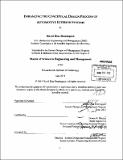| dc.contributor.advisor | Donna H. Rhodes. | en_US |
| dc.contributor.author | Diaz Dominguez, David | en_US |
| dc.contributor.other | System Design and Management Program. | en_US |
| dc.date.accessioned | 2012-05-15T21:13:15Z | |
| dc.date.available | 2012-05-15T21:13:15Z | |
| dc.date.copyright | 2011 | en_US |
| dc.date.issued | 2011 | en_US |
| dc.identifier.uri | http://hdl.handle.net/1721.1/70797 | |
| dc.description | Thesis (S.M. in Engineering and Management)--Massachusetts Institute of Technology, Engineering Systems Division, System Design and Management Program, 2011. | en_US |
| dc.description | Cataloged from PDF version of thesis. | en_US |
| dc.description | Includes bibliographical references (p. 152-154). | en_US |
| dc.description.abstract | Product development cycles in the automotive industry are being reduced and competition is more demanding than ever before. To be successful in this environment, Original Equipment Manufacturers need a product development process that delivers best-in-class value, at a competitive cost and with the shortest lead time. Within the development process, the conceptual design is the most important phase in the delivery of a nocompromise design solution. In this phase, design teams have the largest amount of latitude to create value in the product, but they also face high levels of uncertainty and incomplete information to make decisions. At a high level, the conceptual design phase encompasses four major steps. In the first step, value is defined from the stakeholder perspective and system objectives are defined. The second step involves a divergent process in which design space is explored and several concept alternatives are generated to meet the system objectives. The third is a convergent process in which design alternatives are matured, evaluated and one is selected. In the fourth step, the architecture of the system is articulated. The intended impact of this thesis is to enhance the value delivered in the conceptual design phase and prevent waste in downstream activities within the product development process. To achieve this, the conceptual design processes of a major automotive manufacturer were studied to identify the problems that constrain value delivery and generate waste. The findings of this study and the exploration of existing concept development frameworks were synthesized in a concept development methodology focused on automotive Exterior Systems. | en_US |
| dc.description.statementofresponsibility | by David Diaz Dominguez. | en_US |
| dc.format.extent | 154 p. | en_US |
| dc.language.iso | eng | en_US |
| dc.publisher | Massachusetts Institute of Technology | en_US |
| dc.rights | M.I.T. theses are protected by
copyright. They may be viewed from this source for any purpose, but
reproduction or distribution in any format is prohibited without written
permission. See provided URL for inquiries about permission. | en_US |
| dc.rights.uri | http://dspace.mit.edu/handle/1721.1/7582 | en_US |
| dc.subject | Engineering Systems Division. | en_US |
| dc.subject | System Design and Management Program. | en_US |
| dc.title | Enhancing the conceptual design process of automotive exterior systems | en_US |
| dc.type | Thesis | en_US |
| dc.description.degree | S.M.in Engineering and Management | en_US |
| dc.contributor.department | System Design and Management Program. | en_US |
| dc.contributor.department | Massachusetts Institute of Technology. Engineering Systems Division | |
| dc.identifier.oclc | 792882435 | en_US |
